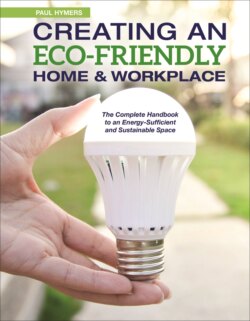Читать книгу Creating an Eco-Friendly Home & Workplace - Paul Hymers - Страница 27
На сайте Литреса книга снята с продажи.
How much light do we need?
ОглавлениеThe US Energy Information Administration (EIA) estimated that in 2016, residential lighting consumption was about 129 billion kWh, which was roughly 10 per cent of the total electricity consumption used in the residential sector for that year. Ten years before, the figure was much higher and equated to about 20 per cent. This is good news but the US Energy Department reported in 2013 that if the country switched over entirely to LED lights over the next 20 years (by 2033), it could save $250 billion in energy costs, reduce electricity consumption for lighting by nearly 50 per cent and avoid 1800 million metric tons of carbon emissions being released. Given the knowledge and technology available now to bring the carbon-emissions from lighting down by such a significant amount, not just in the US but in the rest of the world too, it is incumbent upon us as house-holders to make it happen and fast.
Before the advent of low-energy lighting in the UK, we were consuming about 58,000 gWh worth of electricity every year in lighting our buildings artificially in the UK alone. About 20 per cent of all the electricity we burnt also went to lighting up. In 2017 on average, lighting up our homes with LED lamps means we use over 75 per cent less energy than when we relied on the old incandescent bulbs. By switching to LED, most of us have already saved about £150 per year on the annual electricity bill and more importantly reduced our annual carbon dioxide emission by half a tonne.
A COMPARISON OF FIVE LAMP TYPES
Tungsten-filament
Energy efficiency variable between 1 and 20 lumens per watt, but generally very poor with an average inefficiency of 91 per cent. The traditional standard bulb has a yellowish light of 2000 deg.K. unless in a corrective blue glass bulb as a daylight correction type. This type of lamp should not be used for ambient lighting due to its power consumption and short life expectancy.
Tungsten-halogen
Very popular since the 1990s. White and crisp light, typical as low-voltage or mains-voltage recessed spotlights. Colour temperature of around 3000 deg.K. Small and long lasting, tungsten-halogen lamps produce focused light that works well in uplighters and downlighters. The low-voltage types do have slightly better energy efficiency, but the transformers needed to convert mains-voltage to low-voltage use power inefficiently and thus are a problem. As small spotlights, they should not be used in multiples to provide ambient lighting.
Metal-halide
New for domestic interior use, these lamps offer high efficiency, making them cheap to run. In the form of high-intensity-discharge (HID), they have been used in car headlamps and street lighting as sodium (orange glow) lamps – the most efficient light source known to man. Now also in garden spotlights. For indoor use, the white light halides have five times the efficiency of standard tungsten bulbs. In this form, they provide the most natural light available at between 4200 and 4600 deg.K.
Fluorescent
Tubular: The light tends to be cold and bluish from standard fluorescents, but the later T8 ones were the last to be replaced by LEDs. Diffusers help kill the glare, but look cheap and collect flies, making them undesirable. Compact: Initially the best energy efficiency replacement for tungsten bulbs, they were slow to light up and considered too dull for task lighting.
LEDs
In 2017 they have replaced all other light bulbs including tubular fluorescents – 100–250 lumens per watt at present – but still increasing with advance of technology. The temperature of white LEDs is very close to daylight, with a slightly blue cast, making them an ideal pure light source for task and accent lighting.
Time magazine declared 2013 to be the year of the LED lamp, but I would have said it was 2014 in the UK. Partly because although we had replaced the halogen GU10 fitted spotlight lamps by then with efficient LED spots, the other standard pendant bulbs weren’t commonly or economically viable before then. The last bastions of the gas lamps were the fluorescent tubes, which hung on in the commercial sector ceilings until 2017, but now out-evolved by the low-cost, long-life and improved performance of LED tubes. (Now LED tubes are commonly used in 8 and 16 watts, to replace traditional 25 watt and 40 watt T8/T10/T12 fluorescent tubes, mostly it has to be said in commercial buildings like offices.) Not much is left for the LED market to conquer. Even the sparkly chandelier market of fittings lit by tiny and bright G4 bulbs that occur by the dozen now have single watt LED replacements. Given the long life expectancy of LEDs, the light bulb retrofit market will presumably decline as rapidly as it appeared.
It has been a triumph of technology and now we can only hope that we can revolutionise power to our homes and vehicles in the same way in the coming years. But even if you have made the bulb changes, the next step will be to convert to intelligent controls and better design of lighting; here the technology is emerging with EL strips and wireless controls.
